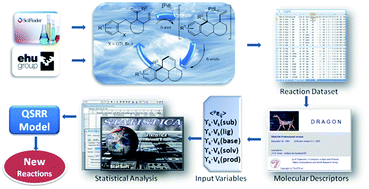Perturbation theory model of reactivity and enantioselectivity of palladium-catalyzed Heck–Heck cascade reactions†
Abstract
Enantioselective intramolecular Heck–Heck cascade reactions have emerged as an excellent tool for the construction of polycyclic frameworks, such as lycorane alkaloids, xestoquinone and analogues. However, it is particularly difficult to rationalize the effect of simultaneous changes in both the structure of many molecular entities and experimental conditions (temperature, time, solvent, ligand, catalyst loading, etc.) on reactivity and enantioselectivity. In this work, a computational model to predict the enantiomeric excess and the yield of Heck–Heck cascade reactions has been developed. The model combines Perturbation Theory (PT) and Quantitative Structure-Reactivity Relationships (QSRR) ideas for the prediction of two different outputs with the same equation (% ee and % yield). This model predicted 520 experimental outcomes with a correlation coefficient of R = 0.89, standard error of estimates of SEE = 1.19%, and a cross-validation correlation coefficient of q2 = 0.79. The use of the model has been illustrated with a case study, the Heck–Heck cascade reaction of a 2,3-dialkenyl pyrrole using Pd(dba)2 and (R)-BINAP. For the first time, a 2000-points simulation in ternary phase diagrams shows the effect of the concentration of the catalyst, the base, and ligand on the enantioselectivity of this reaction. The QSRR model also predicts trends in structural outcomes, such as halides vs. triflates, or the ligand structure. Therefore, the model opens the door to the design of new chiral ligands and helps to find trends to improve the experimental results in enantioselective polyene cyclisations.


 Please wait while we load your content...
Please wait while we load your content...